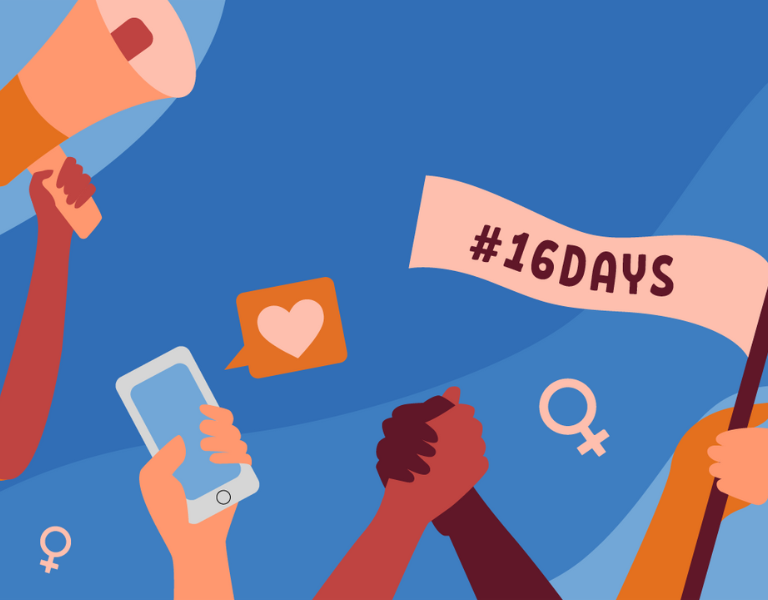The 16 days of activism against gender-based violence gives focus to the continued need for action to eradicate violence against women (VAW). VAW occurs at epidemic levels with one in three women affected globally. In Scotland, one in four women experience domestic abuse in their lifetime, and 70% of women report that they’ve experienced or witnessed sexual harassment at work.
VAW is not often seen as a workplace issue, despite it affecting all aspects of women’s lives. Perpetrators of domestic abuse use a range of tactics to disrupt women’s employment as a way to coerce and control. This can include using workplace resources such as phone and email to threaten, harass or abuse them. Other tactics can include destroying work clothes and personal documents which may prevent them from applying for jobs in the first place. In addition, we know that the cost of childcare is prohibitive for many women, and so the reliance upon abusers to provide childcare which is then deliberately withdrawn is damaging to women’s wellbeing, their ability to do their job, and ultimately their career prospects.
There is a critical link between VAW and poverty, with financial dependency and poverty being primary risk factors for victim-survivors, making it difficult to leave abusive relationships. We know that VAW is both a cause and consequence of gender inequality, and that women’s poverty is intrinsically linked to this and sustains these ingrained inequalities faced by women. This is why it is essential to address women’s labour market inequality and tackle women’s poverty to prevent violence against women.
The link between violence against women and women’s labour market inequality
Women’s labour market and economic inequality reduces their financial independence, restricts their choices in employment and creates a conducive context for VAW. Living in poverty can also make it harder for women experiencing violence or abuse to move on and maintain employment.
Women are not a homogenous group and their experiences of men’s violence and also workplace inequality, are shaped by the intersecting and compounding inequalities they face. For example, socioeconomic background has an influence on women’s labour market outcomes, with women from lower socioeconomic backgrounds being less likely to be represented in higher paid jobs, and more likely to be in lower-paid, stereotypically female, work such as care and cleaning. This drives the higher level of female poverty which diminishes women’s options in the face of violence and abuse.
In tackling women’s poverty, women’s labour market inequality, and wider gender inequality, it’s vital to understand that barriers to paid employment are costly to women’s safety. Employment itself is not necessarily a guaranteed route out of poverty either, due to the low levels of pay and the prevalence of zero-hour contracts that are associated with ‘women’s work’. Women are significantly more likely to be employed on zero-hour contracts than men, with this figure growing sharply in the last decade. Moreover, it is not just the insecure nature of these jobs that are a threat to women’s long-term financial stability and overall safety, but zero-hour contracts are notoriously characterised by low pay, with just 40% of employees on zero-contracts having an hourly earnings that matched (or higher than) the 2021 Living Wage. The financial instability due to these precarious contracts can limit women’s choices when facing violence and abuse. Addressing women’s labour market inequality is therefore a necessary step in ending violence against women.
The gendered nature of poverty and its link to violence against women
There is no escaping that poverty is gendered in Scotland. Women are more likely to be living in poverty than men, with a disproportionate number of women, particularly single mothers living in poverty. Women in Scotland who are on low incomes are more likely to be impacted by the cost of living crisis, especially with deepening poverty and facing hardship including hunger, going without essential items, and inability to afford to heat their homes.
Moreover, it has been acknowledged also that worsening debt is connected to the gendered cycle of violence, with debt being linked to experiences of domestic abuse. Poverty itself is associated with domestic abuse as both a cause and a consequence of violence against women which is why it is relevant in understanding the connection between poverty and gender inequality.
While financial abuse and economic abuse are often used interchangeably, the difference is that economic abuse consists of the many different ways an abuser may control someone’s economic situation, extending to the restriction of accessing food, transport, employment, and housing. Financial abuse is thus a sub-category of economic abuse, involving the use or misuse of money to control someone’s life which may include coercing a victim-survivor into taking on debt, or controlling their finances. A survey of 4,000 women found that women were more likely than men to experience financial abuse with over half of women reporting that they experienced financial abuse having personal incomes below £20,000 annually. Women’s exposure to abuse is prolonged by poverty, as victim-survivors often cannot afford to leave an abusive partner, especially in the current context of the cost-of-living crisis.
For those who experienced economic abuse, the most common stage at which the abuse started was when their pay decreased due to the coronavirus, with 35% reporting this. This reinforces that in times of financial uncertainty, whether due economic shocks, low pay or poverty, this is a conducive context for abuse to happen. Women are more likely than men to report economic abuse, with 89% of women who experienced economic abuse, and reported experiencing other forms of abuse with higher rates of physical, emotional and sexual abuse compared to men. The long-term impact of economic abuse can make it more challenging for victim-survivors to rebuild their lives. While economic abuse is more likely to occur within the context of domestic abuse, it is also prevalent in other situations, including when a woman is being sexually harassed at work.
Structural inequalities require structural solutions
To prevent violence against women, it’s critical to address gender inequality in the workplace. By advancing women’s labour market equality, and dismantling gendered barriers such as inflexible work, the high and prohibitive cost of childcare, inadequate support for victim-survivors in the workplace, low-paid and low-quality part-time roles, only then can we be closer to eradicating men’s violence against women.
Close the Gap’s Equally Safe at Work accreditation programme directly supports employers to improve their employment practice to advance gender equality at work and prevent violence against women. In the most recent roll out of the programme, 14 new public and third sector employers have become accredited, taking the total to 18 across Scotland. Findings from the evaluation in local government, NHS and third sector 2022-2023 found that employers across sectors have, as a result of participating in the programme, taken a wide variety of action to improve their employment practice to be more gender- and VAW- sensitive. This included but was not limited to, the introduction of special leave for victim-survivors, the implementation of new policies including a VAW policy and a standalone sexual harassment policy as well as the development of new data collection systems. Further action saw employers review and update existing policies on flexible working, recruitment, equal opportunities, and organisational change. Alongside this, innovative awareness-raising campaigns highlighted the organisational commitment and dedication from employers in preventing VAW.
Employers have a critical role to play in preventing violence against women in and outwith the workplace, and advancing gender equality. However, to rely solely upon increasing women’s labour participation as the solution to gender equality, and a safeguard against poverty, is reductive. Further understanding and action is required to address the structural inequalities within the labour market. These contribute to and sustain women’s inequality, especially the systemic undervaluation of women’s work which drives women’s and children’s poverty.
To find out more about Close the Gap or Equally Safe at Work, please visit the website at www.ClosetheGap.org.uk or www.EquallySafeatWork.scot



Enter your email address to receive regular e-updates about our work. If at any time you want to stop receiving these, simply contact us. We’ll keep your details safe and won’t share them with any other organisations for their marketing purposes. For full details see our Privacy Policy.